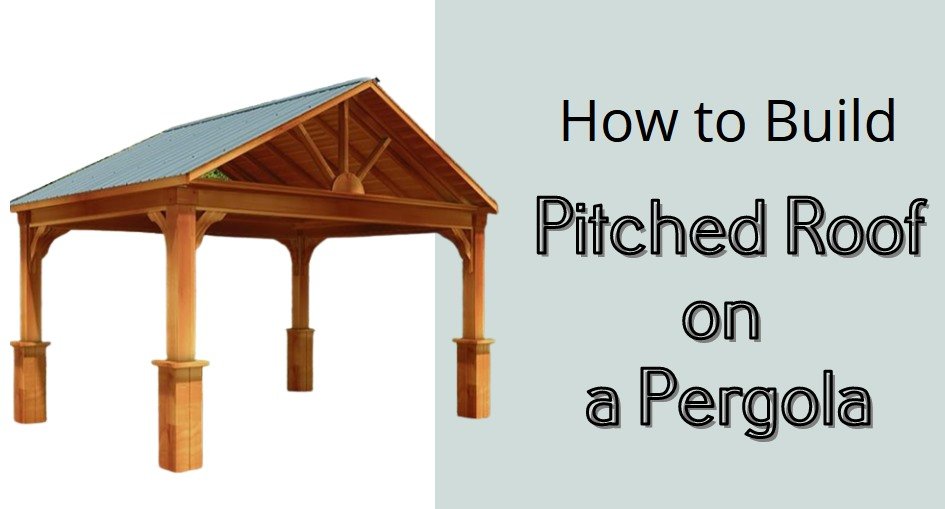The pergola’s roof is one of the structures that provide extra shade in the home, shelter from the elements, and daylight for a room.
Because it is shaded from the sunlight, the space beneath the pergola has become more shadowy and may be used for various purposes. Pergolas provide shade for outdoor spaces such as terraces, garages, or living rooms.
The roof is frequently coated with glass or fiber to endure rain and climate. Many individuals are interested in constructing a pergola within their house and its distinct appearance. You may wonder how to build a pitched roof on a pergola. If that is true, perhaps, you may not skip the brief information in today’s article below.
Building a Pitched Roof On a Pergola
These are some ways to build a pitched roof on a pergola that you can follow at home.

- Choosing a Pitched Pergola Roof Design
When choosing a pitched roof pergola design, consider options like powder-coated aluminum for durability and weather resistance. This material offers a refined look and withstands diverse weather conditions, making it ideal for various climates.
A pitched roof pergola adds a touch of luxury to your outdoor space, serving as an elegant extension of your living or dining area. Whether you’re enjoying a morning coffee, hosting a dinner party, or relaxing under the stars, this structure provides a seamless connection between your home’s interior and exterior.
The broad, meadow-pitched pergola may be employed to develop an open porch with furnishings on which you can amuse your visitors on beautiful mornings and evenings.
Pitched roof pergola designs for a backyard can be simple, tilted on one aspect for rainfall drainage, or perhaps even left open for an accessible, breezy private place for the residents.
- The 1st Step: Install the Pitched Roof Posts
The first step is to drill deep trenches to put the posts in. The roofs are often sloped on either side to provide a slope that provides adequate rain or snow draining.
Dig one-foot-long holes. The space between gaps must be uniform to provide enough reinforcement to the roof.
There may be 3 to 5 poles based on the scale of the pergola with a pitched roof. Set the poles in the appropriate holes based on height and position, then pour concrete for strong support.
- The 2nd Step: Shade Canopy Drilling and Screwing
A first board must be set on that pergola with a pitched roof border. Create holes with the drill tool and securely screw the board towards the pergola. Calculate the length using the spacing to verify that the spacing between subsequent screws is roughly consistent.
- The 3rd Step: Joist Ends Sizing and Trim
In this third step of building a pitched roof on a pergola, ensure they are all the same size when you have most of the joists for the pitched roof pergola ready to go. Fasten the joists to a massive piece of lumber and then use a cutter to chop them all down along the wood lining to retrieve identical details.
- The 4th Step: Connect the Joist Ends to the Shade Canopy
Whether on this step of how to build a pitched roof on a pergola, retighten the joists once more to all the wooden beams, beginning with the very first cover board on the edge of the platform, to build a sturdy roofing structure before installing the metal roofs as well as a sheet.
- The 5th Step: Installation of Roofing Materials
When the structure for the pergola’s pitched roofs is set, the next stage is to cover the frames.
Based on the material, it is strictly connected to the frame for sturdy and long-lasting placement. Metal roofing panels, for example, are fastened and pressed to the timber structure. For added robustness, some individuals use galvanized fixings.
Install drains from either face of a slanting thatched roof for the maximum certainty of water removal.
| Material | Durability | Weather Resistance | Aesthetic Appeal | Maintenance Level | Cost |
|---|---|---|---|---|---|
| Powder-Coated Aluminum | High | Excellent | Modern/Refined | Low | Moderate |
| Polycarbonate | Moderate | Good | Transparent/Bright | Low | Low |
| Timber | High | Moderate | Classic/Rustic | High | High |
| Metal Panels | High | Excellent | Industrial/Modern | Low | Moderate |
Building a pitched roof pergola can be a fulfilling project, whether done with family or professionals. As one expert mentioned, ‘The blend of aesthetic appeal and functional design makes a pitched roof pergola not just a shelter, but a true enhancement to your living space, offering comfort and beauty all year round.’


